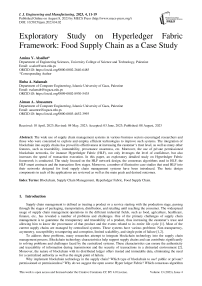Exploratory Study on Hyperledger Fabric Framework: Food Supply Chain as a Case Study
Автор: Amina Y. AlSallut, Ruba A. Salamah, Aiman A. Abusamra
Журнал: International Journal of Engineering and Manufacturing @ijem
Статья в выпуске: 4 vol.13, 2023 года.
Бесплатный доступ
The wide use of supply chain management systems in various business sectors encouraged researchers and those who were concerned to explore and employ efficient technologies to improve such systems. The integration of blockchain into supply chains has proved its effectiveness at increasing the customer’s trust level, as well as many other features, such as traceability, immutability, provenance awareness, etc. Moreover, the use of private permissioned blockchain networks, for instance Hyperledger Fabric (HLF), not only leverages the level of confidence, but also increases the speed of transaction execution. In this paper, an exploratory detailed study on Hyperledger Fabric framework is conducted. The study focused on the HLF network design, the consensus algorithms used in HLF, the HLF smart contracts and the transaction flow stages. Moreover, a number of illustrative case studies that used HLF into their networks designed for food supply chain management systems have been introduced. The basic design components in each of the applications are reviewed as well as the main goals and desired outcomes.
Blockchain, Supply Chain Management, Hyperledger Fabric, Food Supply Chain
Короткий адрес: https://sciup.org/15018702
IDR: 15018702 | DOI: 10.5815/ijem.2023.04.02
Текст научной статьи Exploratory Study on Hyperledger Fabric Framework: Food Supply Chain as a Case Study
Supply chain management is defined as treating a product or a service starting with the production stage, passing through the stages of packaging, transportation, distribution, and retailing until reaching the consumer. The widespread usage of supply chain management operations in the different industrial fields, such as food, agriculture, healthcare, finance, etc., has revealed a number of problems and challenges. One of the primary challenges of supply chain management is to guarantee the transparency and traceability of a product, thus increasing the customer’s trust and allowing him to know the provenance of that product and the events related to its entire life cycle [1]. Most of the current supply chains are managed by centralized systems. These systems have various problems: Non-transparency, asymmetry, susceptibility to tampering and corruption, limited scalability, and single point of failure [1,2].
To address these problems, many researches attempt to integrate blockchain technology into the supply chain management process. Blockchain technology characteristics help support supply chains and can contribute significantly to solving problems and challenges faced by the centralized systems. These characteristics can ensure the authenticity and traceability of information during transmission and the security of transactions in a distrusted environment [2]. Moreover, the nature of blockchain with its distributed ledger offers trusted and immutable data, eliminating the need for a centralized authority as well as the single point of failure.
Why implement blockchain technology in the supply chain? Which type of blockchain to use? public or private? permissioned or permissionless? Why do we suggest the open source Hyper ledger Fabric? Which consensus algorithm is required? These questions are discussed in this paper.
The existence of many blockchain platforms that allow the development of blockchain-based applications which can either be permissioned or permissionless encouraged the researchers to employ these platforms to build blockchainbased applications efficiently. Ledger Live from Ethereum, Hyperledger, and XRPL ledger are examples of blockchain frameworks. Hyperledger Fabric, which is an open source, private and permissioned blockchain framework, acts as a foundation for developing blockchain-based supply chain models for different types of products.
Block-chain employs the principle of consensus to validate a transaction into a ledger. In a consensus process, every blockchain node agrees on the network's present state. This ensures that every network user keeps a consistent copy of the distributed ledger. There are various types of consensus methods that operate according to different principles. The performance of the blockchain is directly impacted by the consensus algorithm used. However, there is a lack of theoretical and data support for the selection and performance assessment of the applied consensus algorithms in many of the existing supply chain models that leverage private blockchain platforms.
In this work, an exploratory study on Hyperledger Fabric framework is conducted in detail. Specifically, the major components of HLF, as well as the main phases of transaction flow are explained. In addition, the most popular integrated tool, which is used to capture various time and performance metrics of HLF networks, namely “Caliper '' is introduced. Moreover, different blockchain-based food supply chain management systems are presented as case studies that used the Hyperledger Fabric in their blockchain networks design. Four case studies are presented: WallMart’s Pilot with IBM, Malaysian Halal Food Industry, Agri-food Supply Chain, and PreCast Supply Chain Management.
2. Literature Review
As mentioned earlier, there is a variety of researches aimed at integrating blockchain technology in supply chain management systems. This integration has also started to spread widely among different food products, due to its characteristics and its paramount importance in increasing the level of consumer confidence. The following is a review of the most important food supply chain research that used blockchain technology.
According to Walmart, blockchain technology and the decentralized food supply network could work well together [3]. The company, in partnership with IBM, created a food traceability system based on Hyperledger Fabric. The system was tested by running two projects, one project was about tracing mangos sold in Walmart’s US stores and the other aimed to trace pork sold in its China stores. This system was considered as the pioneer in its field. In[4], a blockchainbased agri-food supply chain traceability system with a full model is proposed. An implementation prototype based on Hyperledger Fabric is also provided , with a concentration on the use of smart contracts which include some procedures that enable the storage and updating of traceability data as well as the reconstruction of an accurate history of all transactions involving a product throughout its life cycle. Likewise, a fully decentralized, blockchain-based traceability solution for Agri-Food supply chain management is presented by [5]. Various IoT sensor devices have been integrated into their solution. Also, Ethereum and Hyperledger Sawtooth, two distinct blockchain implementations, were used and compared.
Moreover, [6] provided a review to foster discussion and encouraged the application of blockchain technology, especially in the agri-food industry. A study that used Hyperledger Fabric to implement a blockchain framework for the Halal Supply Chain scenario [7] utilized the raft consensus algorithm to establish a blockchain network with three channels. The authors claimed that they used raft due to its easier implementation. Also, a new information management system for a precast supply chain based on blockchain is implemented and validated with a case study [8]. It is also one of the first studies to address the information gaps in the construction industry by using the blockchain technology. In [9], a model is created with the goal of enhancing the features of visibility measurements for information exchange, traceability, and inventory visibility, with the extension of the Hyperledger Composer. The traditional supply chain and cloud-based information system have been evaluated using common performance indicators for time and average inventory levels.
Also, some researches have addressed the barriers that prevent the use of blockchain technology. Critical analysis of the technical and non-technical obstacles to the use of blockchain for supply chain applications is done by [10], along with summarizing a range of state-of-the-art consensus algorithms. An attempt to generalize a reference architecture for consensus in permissioned blockchain networks is introduced in [11], with the goal of guiding all Hyperledger projects towards modular designs.
One of the most important topics covered in the research in this field is the performance analysis of the various applications of Blockchain. [12] evaluates the fabric platform's transaction performance. In particular, they mainly concentrated on the impact of the programming language used to develop the chaincode and the number of contributing endorser nodes on transaction latency. Additionally, a mechanism for evaluating the performance of the consensus algorithm of Ethereum and Hyperledger Fabric is developed in [13], where quantitative analysis of latency and throughput with different numbers of transactions have been done. Their work has the purpose of assisting blockchain developers in choosing a consensus method. A similar work [14] evaluated the performance of two well-known consensus mechanisms on the Ethereum platform and four consensus algorithms on a blockchain network that was implemented naively.
3. Background
This section presents an overview of blockchain networks, Hyperledger frameworks with a focus on Hyperledger Fabric, and consensus mechanisms.
-
3.1. Blockchain and Smart Contracts
-
3.2. Hyperledger Fabric network
In December 2015, the Linux Foundation launched a group of open source and free technologies and programs called Hyperledger [18]. The start of 2016 had seen the beginning of the Hyperledger projects' active development, which entailed the creation of further frameworks and tools. Fabric, Sawtooth, Iroha, Indy, and Burrow are examples of Hyperledger frameworks, or distributed ledger technology (DLT) [19]. The development of support tools is an ongoing investment for Hyperledger. Access to Blockchain is made simple and effective by a number of technologies. Among the tools, Hyperledger Composer, Hyperledger Cello, Hyperledger Explorer, and Hyperledger Caliper are the most popular [16]. Each of the Hyperledger tools has its own specific advantages in certain applications.
A specific form of distributed ledger technology is block-chain. As a collection of transactions known as blocks, the data is stored on the blockchain. Each block has a hash value, and the current block links to the prior block by mentioning the previous block's hash value in the header. As a result, data manipulation is impossible using the blockchain since even little changes result in obvious inconsistencies across linked blocks. [15].
There are two types of blockchain networks: public and private. Public blockchains are accessible to everyone and allow for anonymous user registration, transaction submission, and consensus participation. Bitcoin, Ethereum, Dash, and Litecoin are a few examples of public blockchains [16]. Private blockchains have an additional membership layer, limiting access to the blockchain and its many components to individuals who have been authorized. Examples of private Blockchain are Hydrachain Ripple, Monaco and Hyperledger Fabric [15, 16].
A smart contract, also called chaincode, is a program code that implements the application logic and runs during the execution phase [17]. Blockchain uses were previously restricted to the creation of cryptocurrencies and straightforward financial transactions. The creation of smart contracts has made it possible to build a wider range of blockchain-based apps [15].
A consensus process is used in order to add a valid block to the blockchain. There are numerous consensus mechanisms with a performance-security trade-off [15]. The correct order of transactions on Blockchain is guaranteed by the consensus process, a predetermined cryptographic validation technique. The consensus algorithm outlines the guidelines through which network users might come to an agreement regarding transaction validation. The most commonly used algorithms are Proof of Work (PoW), Proof of Stake (PoS), BFT, PoA, PoET, etc [16]. Further discussion on different consensus algorithms implemented in Hyperledger Fabric will be held in later subsections.
A distributed operating system called Hyperledger Fabric runs distributed applications created in general-purpose programming languages on permissioned blockchains (e.g., Go, Java, Node.js). There is no cryptocurrency built into it, and it securely records the execution history in an append-only replicated ledger data structure. Fabric departs from the conventional order-execute blockchain architecture by introducing the execute-order-validate architecture. [17].
Based on the technologies of permissioned blockchain, Hyperledger Fabric (HLF), developed by IBM, is used. It is created to act as a foundation for blockchain applications in a variety of industries. [20]. HLF design has the flexibility of adding and removing components as needed, such as membership and consensus services (plug-and-play). In order to create the application logic using smart contracts (referred to as chaincode), Docker container is included [21]. Through the use of a channel isolation scheme, transactions can only be viewed by nodes that have been granted to a certain channel Thus, the network is able to maintain the privacy of its transactions [18].
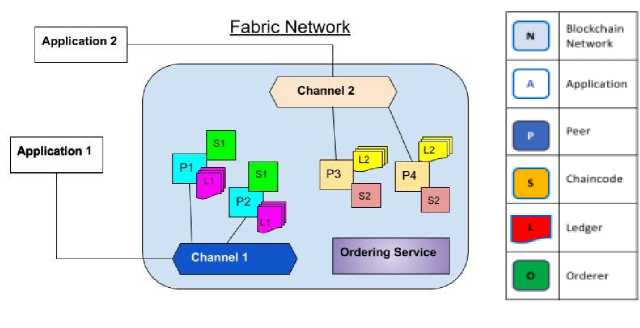
Fig. 1. Main HLF Components
Based on [22], Hyperledger Fabric network typically consists of the following main components as shown in Figure. 1 below:
-
3.2.1 The Ledger
-
3.2.2 Membership Service Provider (MSP)
-
3.2.3 Client
-
3.2.4 Peers
-
3.2.5 Channel
A core idea of Hyperledger Fabric is the ledger; it contains crucial factual data about business objects, including the current value of the objects' attributes and the history of the transactions that led to their current values. It consists of two parts: a world state and a blockchain [23]. The former is a database that contains a set of ledger states' most recent values. Instead of having to calculate it by going through the full transaction log, the world state makes it simple for a program to retrieve the current value of a state.
Blockchain is a digital log of all the transactions that have led to the current world state. To trace the history of changes that have led to this value, transactions are collected into blocks that are appended to the blockchain.
MSP can be defined as the standards used to verify and authenticate IDs. Access to a blockchain network is made available via the membership service provider (MSP). It manages user identities and checks clients trying to access the network. This involves providing these customers with credentials so they can propose transactions. Depending on the identification that has been validated, the MSP employs a certificate authority (CA), which is effectively a plug-and-play interface, to validate or deny the user certificate.
A transaction proposal is created by the client system, also called an application. In order to collect proposal responses from endorsements to conform to the endorsement policy, the client simultaneously submits the transaction request to various peers. The transaction is subsequently forwarded to several orderer nodes to be included in a block, which is ultimately shared with all peers for commitment and verification.
Peer nodes execute the chaincode, the software that represents smart contracts and keeps the ledger in a file system. Chaincode has access to the shared world state according to the well defined ledger protocols.
Peers can also be categorized as either committing peers or endorsing peers. A transaction is endorsed by the endorsing peer using chaincode logic, whereas, the chaincode logic is not present on the committing peer. All peers keep the ledger regardless of this distinction.
In order to connect to the wider network, a channel that serves as a private communication mechanism is used. A separate ledger exists for each channel, which is accessible to all participating organizations and peers in that channel. The ability to conduct private communication between the firms only through the same channel may be useful in instances involving competing companies.
-
3.2.6 Ordering Service
-
3.3. HL Transaction Flow Stages
-
3.3.1 Stage1: Execute
To reach consensus, HLF employs orderer nodes. Organization of transactions into a block and distribution of that block to all peers for confirmation constitute the primary duties of an orderer node.
Three distinct ordering service implementations are used by HLF, which are Solo, kafka, and Raft. The ordering service has a consensus system that is flexible and modular. In a solo-based implementation, there is just one ordering node. Therefore, a single point of failure is still presented and this makes solo inappropriate for production. However, it can be utilized for testing and academic research. In Kafka, a follower and a leader concept are used. The task of the leader orderer is to send transactions to the following nodes. Given that other nodes are functioning, the choice of the leader is made dynamically.
Since Kafka is derived from Crash Fault Tolerant (CFT), it allows the process to continue even when some of the current nodes have N failures but N/2 + 1 nodes are still able to function. The main challenge is that it is difficult to set up a Kafka-based ordering service and an expert deployment is needed.
Raft is a recently released ordering service by HLF based on the Raft protocol. It is similar to Kafka in that it employs the leader-and-follower technique and is CFT. Technically speaking, Raft and Kafka have no significant differences. However, there is a noticeable variation in how the two implementations of ordering service nodes operate. Raft has a distinguished advantage over Kafka that is simpler to set up and deploy.
The three stages of a completed transaction in Hyperledger Fabric network are execute, order, and validate. Detailed explanation of these stages is below.
This stage involves communication between a collection of peers and an application. Orderers are not involved. A request to the endorsing peers of various organizations is sent to endorse the proposed chaincode invocation's results.
Applications create a transaction proposal and send it for approval to each of the necessary peers. Then, independently, each of these endorsing peers runs a chaincode on the transaction proposal to produce a transaction proposal response.
This update is not applied to the ledger; rather, it is just signed and sent back to the application. The application will complete the first stage of the transaction flow after it has accumulated a sufficient number of signed proposal responses.
-
3.3.2 Stage2: Order
-
3.3.3 Stage3: Validate
2. invoke chaincode (proposal)
3. proposal response
4. request that transaction is ordered
After completing phase1, clients are in charge of creating transactions and broadcasting them to the ordering service. The channel ID, transaction metadata, a list of endorsements, and payload are common components of a transaction. When the Orderer receives the responses from the clients, it sequentially orders the signed transactions into a block.
The Orderer preserves a full order and consensus for all transactions within a channel. The created blocks are then distributed to peers.
The block is received by both peers, including endorsers and committers, and then is decoded by them. Any peer on the channel may independently verify the transactions in the block. Every peer uses the exact same procedure to validate the block. As a result, each peer will have the same copy of the ledger, guaranteeing consistency.
The signature of the orderer is validated by all peers, after which all checked signatures are decoded and all transactions are confirmed. Figure 2 summarizes the transaction flow in Hyperledger Fabric Framework [22].

1. connect to peer
5. ledger update event

N updates ledger using transaction blocks
4.1 Transactions sent to peers in blocks
2.2 chaincode generates query or update proposal response
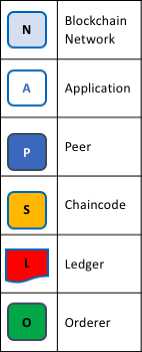
Fig. 2. Transaction Flow in HLF Framework
3.4. Hyperledger Caliper
4. Case Study: Food Supply Chain4.1 Walmart’s Pilots with IBM
Hyperledger Caliper is a benchmarking tool designed specifically for evaluating and measuring the performance of blockchain networks. It provides a framework for testing different blockchain platforms and consensus algorithms, enabling users to assess the performance, scalability, and reliability of their blockchain implementations. It supports various blockchain frameworks, including Hyperledger Fabric, Ethereum, and Sawtooth, among others [24].
With Caliper, users can simulate different transaction workloads and evaluate the blockchain network's response in terms of throughput, latency, and resource consumption. The tool allows users to define specific performance indicators and conduct comprehensive performance comparisons between different blockchain platforms.
Caliper operates by utilizing a modular architecture, enabling users to plug in different performance monitoring systems and deploy customized smart contracts. It also provides an intuitive command-line interface (CLI) and a userfriendly web-based dashboard for easy test configuration, execution, and result analysis.
Overall, Hyperledger Caliper serves as a valuable tool for blockchain developers, researchers, and enterprises looking to assess and optimize the performance of their blockchain applications and infrastructure.
This section introduces some of the most popular projects that employed blockchain in their supply chain management systems. In particular, the use of Hyperledger Fabric framework to design the food supply chain systems.
Walmart and IBM collaborated to create and deploy their blockchain-based food provenance pilot system. This system is a pioneer in its field [3]. Blockchain offers what traditional databases cannot, including data immutability, speed, and security of dissemination, which helps businesses handle problems where trust is a component of the solution. Based on Hyperledger Fabric, IBM's blockchain enables modular design and plug-and-play components including membership services and consensus.
Walmart and its technology partner IBM conducted two proof-of-concept tests to evaluate the system. In one research, mangoes sold in Walmart's US stores were tracked. The other aimed to trace the pork that was sold in its China stores.
The two products' food traceability system, which was built on the Hyperledger Fabric blockchain, was successful. It permitted uploading certificates of validity to the blockchain for pork in China, increasing trust in a system where it was previously a significant problem. And as shown in figure 3, the time needed to trace the provenance of mangoes in the US went from 7 days to 2.2 seconds.

Fig. 3. Time significant reduction in mango tracing system
-
4.2 Malaysian Halal Industry
-
4.3 Agri-food Supply Chain
The existence of a Halal Certification serves as evidence or assurance that the goods are both acceptable and safe under Islamic regulations. This Certification, however, is insufficient to validate the Halal Supply Chain. Customers are required to confirm that both the end product and the manufacturing process used to create it are halal.
This study uses Hyperledger Fabric to implement a blockchain architecture for the Halal Supply Chain scenario, particularly, for meat ordering system [7]. The Blockchain Network contains three channels, which each are made up of two organizations, each of which has a client and two peers. Channel 1 links producers and suppliers, channel 2 links producers and distributors, and channel 3 links distributors and end consumers. Every participant may have a distinct agreed-upon price, securing their privacy by the independent design of the three channels. Using the Raft consensus mechanism, five orderer nodes have been established as part of the Blockchain Network. Figure 4 illustrates the channels created for the system.
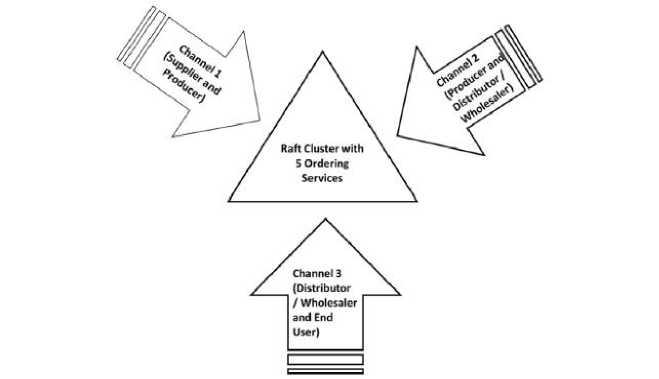
Fig. 4. Private channels in Halal meat supply chain
With the goal of providing quality, integrity, and traceability related to one or more products, a prototype for agrifood supply chain was implemented by [4].
The basic part of the system is a permissioned blockchain, which is built using the Hyperledger Fabric framework. The system business is regulated by smart contract (chaincode). Five well known organizations identified by a unique identifier are involved, each of which has its role in the system, the producer, the manufacturer, the deliverer, the retailer, and the regulatory department organizations.
Each organization has a set of users each of which is certificated by the certificate authority associated with that organization. A client application facilitates communication between users and the blockchain with frontend hosted by a web server owned by its corresponding organization. The smart contract operations that can be performed by each organization is defined by the RoleSet associated with that organization. Figure 5 shows the supply chain scenario using HLF.
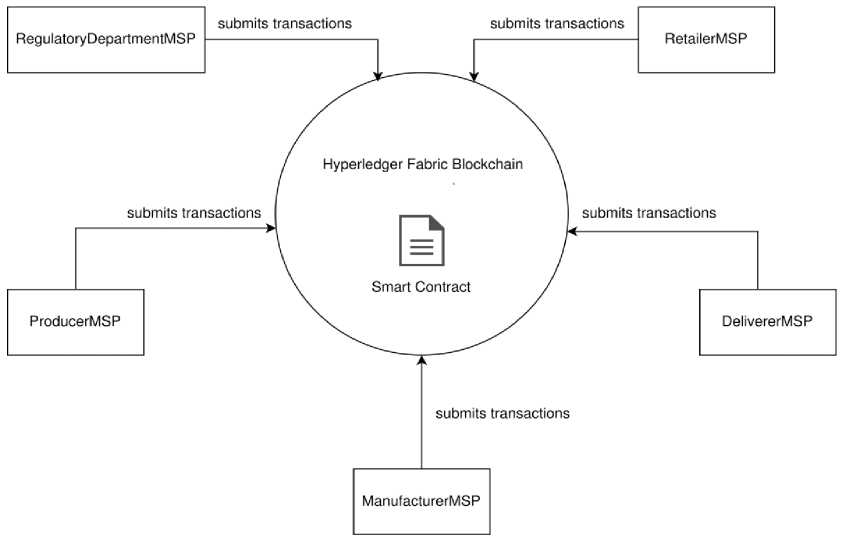
Fig. 5. Supply Chain for Agri-food scenario
The proposed system was applied to Orange-Juice use case. The implementation of the use case indicates that the suggested system can handle all aspects of an agri-food product's fundamental lifetime, from production to consumption. The basic rules presented also demonstrate the framework's versatility in allowing any type of rule to be added at runtime in order to deal with particular quality control tactics required by every enterprise engaged in the supply chain.
4.4 PreCast Supply Chain Management
5. Conclusion and Future Work
A study aimed at resolving the challenges associated with precast supply chain with a blockchain-based information management framework built for a precast supply chain (BIMF-PSC). The research views the development process, and details the smart contract algorithms used to implement the model [8]. A case study that uses a visualization system to manage information sharing, control real-time scheduling, and track information demonstrates the effectiveness of the framework. Figure 6 depicts the BIMF-PSC model developed in this work.
The precast supply chain has four major stakeholders: owners, construction companies, off-site factories, and transport businesses. In the BIMF-PSC model's shared ledger, PC data is kept. Every participant has a copy of the ledger that they can use whenever they want to reveal the PC data.
To demonstrate the performance of the proposed BIMF-PSC model, a case study is done. Shanghai Jiangong construction company's project is an important demonstration of precast construction housing in China. The Hyperledger Explorer program was used to view the blockchain network, the Hyperledger Explorer can offer full transaction information, including transaction time, block number, and contents, among other things. As a result, the participants have real-time access to PC data and may follow PC activity.
The developed system can improve real-time information exchanges among diverse stakeholders, which will raise the efficiency of supply chain management. By modifying the smart contract, the idea might also be utilized to address problems in other conventional supply chains.
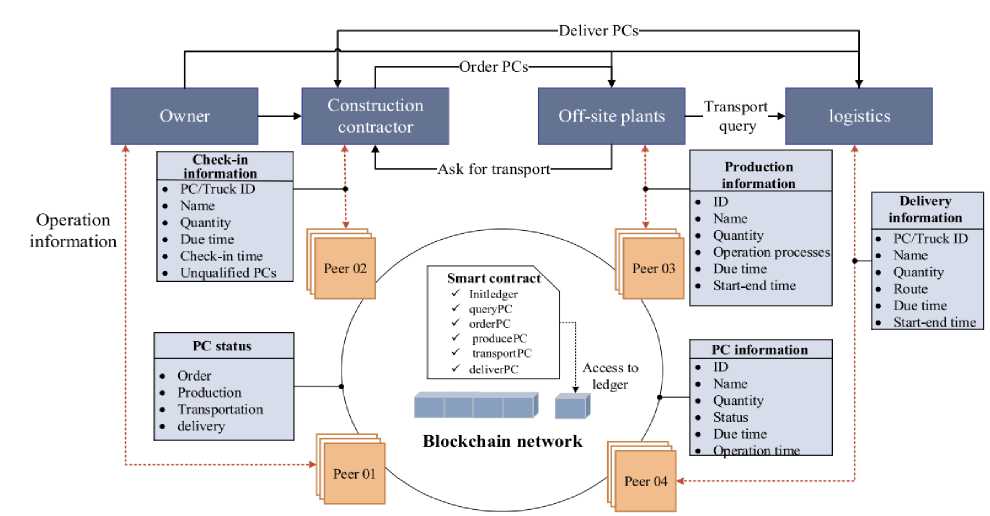
Fig. 6. Framework for blockchain-based information management in a precast supply chain.
In this work, a complete study on Hyperledger fabric (HLF) along with its main components, transaction flow stages and benchmarking tools used to measure different performance metrics is conducted. At the end of the paper, many use cases that employed HLF in food supply chain management systems are briefly explained. The use of HLF, as a permissioned private blockchain, has proved its ability to significantly increase the user’s level of trust, as well as, to achieve superior execution speed, especially for real time applications.
As a future work, a blockchain-based food supply chain management system model will be developed using Hyperledger Fabric, applying different consensus algorithms. Moreover, those algorithms will be analyzed and compared through the Hyperledger Caliper benchmarking tool. This performance evaluation will help selecting the appropriate consensus algorithm related to the product type and preferences.
Список литературы Exploratory Study on Hyperledger Fabric Framework: Food Supply Chain as a Case Study
- M. Angelo and T. Orazio, "An Agri-Food Supply Chain Traceability Management System based on Hyperledger Fabric Blockchain," in 23rd International Conference on Enterprise Information Systems, 648-658. 10.5220/0010447606480658, 2021.
- P. Helo, Y. Hao, "Blockchains in operations and supply chains: A model and reference implementation," Computers & Industrial Engineering, Volume 136, Pages 242-251, ISSN 0360-8352, 2019.
- K. Reshma., "Food Traceability on Blockchain: Walmart’s Pork and Mango Pilots with IBM," The Journal of the British Blockchain Association. 1. 1-12. 10.31585/jbba-1-1-(10), 2018.
- M. Angelo and T. Orazio, "An Agri-Food Supply Chain Traceability Management System based on Hyperledger Fabric Blockchain," in 23rd International Conference on Enterprise Information Systems, 648-658. 10.5220/0010447606480658, 2021.
- M. Caro, M. Ali, M. Vecchio and R. Giaffreda, "Blockchain-based traceability in Agri-Food supply chain management: A practical implementation," IoT Vertical and Topical Summit on Agriculture - Tuscany (IOT Tuscany), 2018
- J. Xu, S. Guo, D. Xie and Y. Yan, "Blockchain: A new safeguard for agri-foods," Artificial Intelligence in Agriculture, 2020.
- I. Surjandari, H. Yusuf, and E. Laoh, "Designing a Permissioned Blockchain Network for the Halal Industry using Hyperledger Fabric with multiple channels and the raft consensus mechanism," J Big Data 8, 10, https://doi.org/10.1186/s40537-020-00405-7, 2021
- Z. Wang, T. Wang, H. Hu, J. Gong, X. Ren et al., "Blockchain-based Framework for Improving Supply Chain Traceability and Information Sharing in Precast Construction," Automation in Construction, 2021.
- A. Mukhtar, A. Romli and N. Mohd, “Blockchain Network Model to Improve Supply Chain Visibility based on Smart Contract,” International Journal of Advanced Computer Science and Applications (IJACSA), 2021.
- S. Jabbar and H. Hammoudeh, " Blockchain-enabled Supply Chain: Analysis, Challenges, and Future Directions," Multimedia Systems, 2021.
- Hyperledger Architecture Working Group, "Hyperledger Architecture Volume 1", White paper, 2017
- L. Foschini, A. Gavagna, G. Martuscelli and R. Montanari, "Hyperledger Fabric Blockchain: Chaincode Performance Analysis," ICC 2020 - 2020 IEEE International Conference on Communications (ICC), 2020.
- Y. Hao, Y. Li, X. Dong, L. Fang and P. Chen, "Performance Analysis of Consensus Algorithm in Private Blockchain," 2018 IEEE Intelligent Vehicles Symposium (IV), 2018.
- Y. Supreet, P. Vasudev, H. Pavitra, M. Naravani and D. G. Narayan, "Performance Evaluation of Consensus Algorithms in Private Blockchain Networks," 2020 International Conference on Advances in Computing, Communication & Materials (ICACCM), 2020.
- S. Rouhani, R. Belchior and R. Cruz , "Distributed Attribute-based Access Control System using Permissioned Blockchain," World Wide Web 24, 1617–1644, 2021.
- K. Marija and K. Lazar, "Hyperledger Frameworks with a Special Focus on Hyperledger Fabric," Military Technical Courier, 2021.
- E. Androulaki, A. Barger, V. Bortnikov, C. Cachin, and K. Christidis et al. ," Hyperledger Fabric: A Distributed Operating System for Permissioned Blockchains," EuroSys '18: Proceedings of the Thirteenth EuroSys Conference, 2018.
- K. Dodo, T. Hashmani and M. Cheong, "Empirical Performance Analysis of Hyperledger LTS for Small and Medium Enterprises," Sensors, 2022.
- V. Dhillon, D. Metcalf and M. Hooper, "Blockchain Enabled Applications: Understand the Blockchain Ecosystem and How to Make it Work for you," New York, NY: Apress, 2017.
- S. Navroop, S. Nathalie, G. Alexandra, S. Robert and G. Arianna, "Blockchain for Business-An Introduction to Hyperledger Technologies," Available online: https://courses.edx.org/courses/course-v1:LinuxFoundationX+LFS171x+3T2017/course/ , 2018
- S. Pongnumkul, C. Siripanpornchana and S. Thajchayapong, "Performance Analysis of Private Blockchain Platforms in Varying Workloads," In Proceedings of the 2017 26th International Conference on Computer Communication and Networks (ICCCN), 2017.
- Hyperledger Fabric, Peers [online], Available at: https://hyperledger-fabric.readthedocs.io/en/release-2.2/peers/peers.html, 2020
- Hyperledger Fabric, ledger [online], Available at: https://hyperledger-fabric.readthedocs.io/en/release-2.2/ledger/ledger.html, 2020
- T. Kuhrt, Hyperledger Caliper [online], Available at: https://wiki.hyperledger.org/display/caliper/HyperledgerCaliper ,2020

